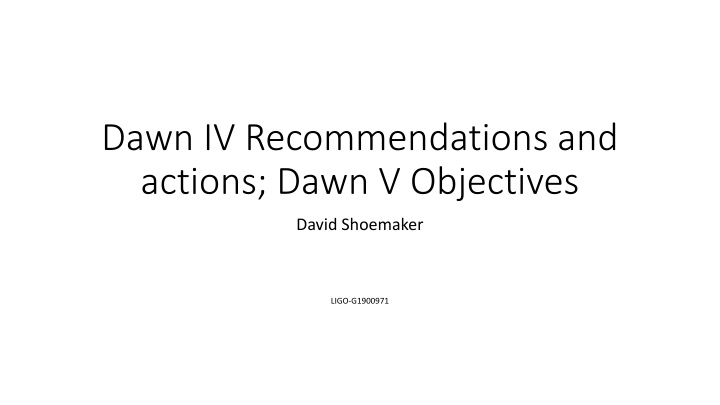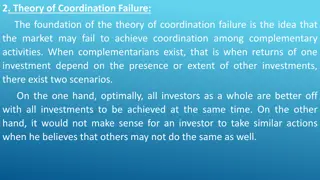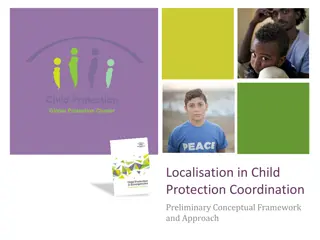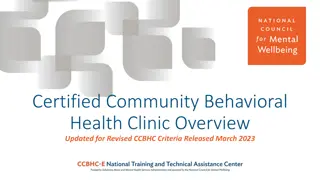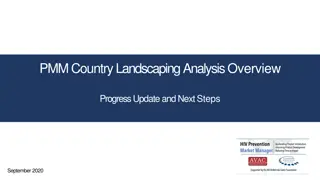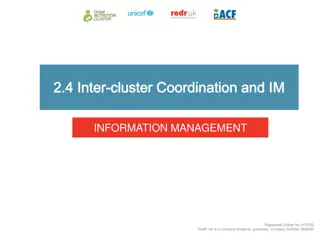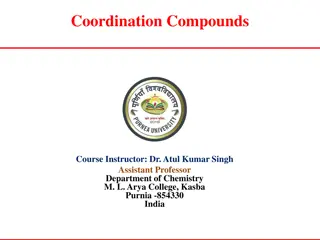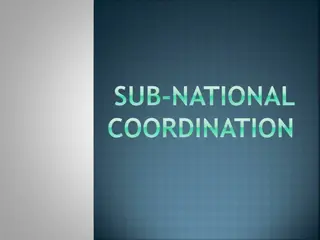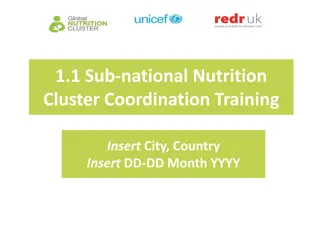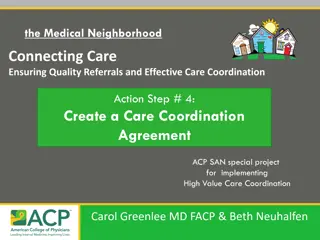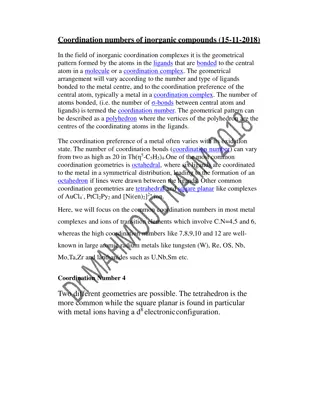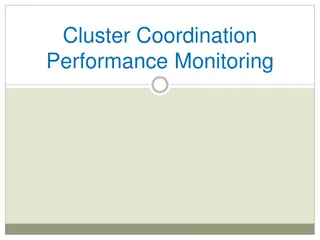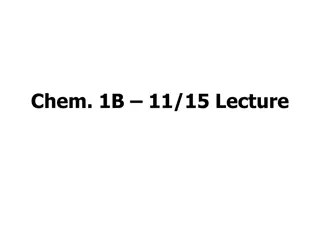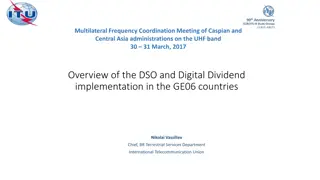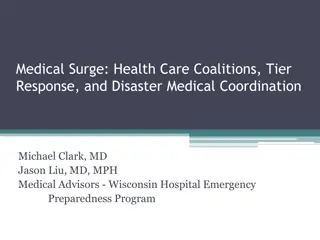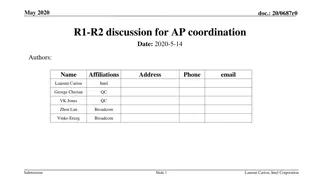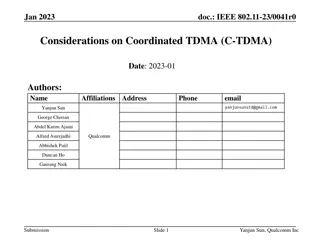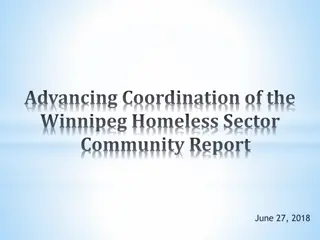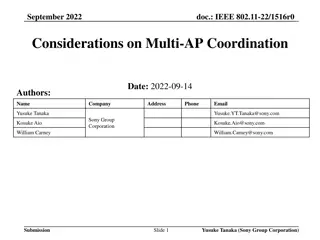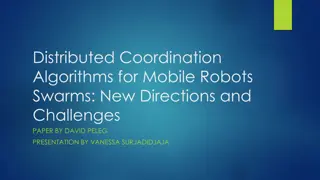Recommendations for GW Community Coordination
The recommendations from Dawn IV highlight the need for coordinating international research and development efforts for 3G detectors. The ground-based GW community is advised to prepare for input to roadmaps and respond to calls for synergies between different projects. Emphasis is placed on exploring astrophysical science gains and evaluating detector requirements. Software and computing development are crucial aspects to address alongside instrumentation and science development.
Download Presentation

Please find below an Image/Link to download the presentation.
The content on the website is provided AS IS for your information and personal use only. It may not be sold, licensed, or shared on other websites without obtaining consent from the author.If you encounter any issues during the download, it is possible that the publisher has removed the file from their server.
You are allowed to download the files provided on this website for personal or commercial use, subject to the condition that they are used lawfully. All files are the property of their respective owners.
The content on the website is provided AS IS for your information and personal use only. It may not be sold, licensed, or shared on other websites without obtaining consent from the author.
E N D
Presentation Transcript
Dawn IV Recommendations and actions; Dawn V Objectives David Shoemaker LIGO-G1900971
Recommendations from Dawn IV GWIC should found an international Umbrella Organization by the Dawn V meeting in Spring 2019 to coordinate international research and development for 3G and detector upgrade plans. Little direct action on this item; a focus of this meeting. GWIC plans to sign off on its creation at its July (Amaldi) Meeting. A Dawn V meeting should be held when the GWIC-led 3G subcommittee report is expected to be released to the community. Here and now.
Recommendations The ground-based GW community should prepare to respond to calls for input to roadmaps. Astro 2020 saw a robust set of White Papers Science Case LSC 2020-2030 plans LIGO Lab concept Preparations underway for a Project proposal to the Decadal from the LIGO Lab Objective is to stimulate wording in the Astro 2020 Decadal report supporting a significant design study for a US 3G detector Due July 10 High Priority APPEC Recommendations to the European Particle Physics Strategy on synergies between ET and CERN (or more generally 3G GW and PP) on science, infrastructure, detector R&D, computing and governance. Discussed in the EPSS Town Meeting in Granada (13-16 May 2019). 10thET Symposium in Sardinia to prepare for ESFRI Submission Preparations underway for ESFRI submission (early 2020)
Recommendations Exploring the astrophysical science gain of a third 3G facility and placement in the southern hemisphere should be a top priority for GWIC. The science case examines the advantages of such a detector We recommend that the 3G science case evaluate the science contribution from below 10 Hz versus above 10 Hz for each item, to help inform detector requirements, and for 500 Hz to 4 kHz, potentially from 2G and 2.5G detectors with shorter baselines of 3-4 km. Cases in the current science case draft: Observing stellar mass BHs throughout the Universe Challenges in waveform modeling IMBHs and eccentric orbits at ~1 Hz
Recommendations The GW community should address the development of software and computing hardware in parallel with the instrumentation and science development. Additional computing committee added; catching up on composing section of Report Computational costs called out in current science case draft: Waveform modeling Parameter estimation
Recommendations The 3G community should continue to explore paths from the current organization of largely independent projects toward a global unified endeavor, with the objective to optimize the use of financial and human resources, and to maximize the science from a 3G network. Coatings/Optics work Becoming unified in US and in Europe, and more coordination US/Europe Needs to move further in this direction Vacuum NSF-funded meeting on innovations in vacuum systems Some European participation Significant non-GW-Field participation Science Case is truly international Significant non-GW-Field participation ET and CE Project efforts rather separate as yet
Recommendations The GW, EM, and neutrino communities should coordinate to identify key joint science targets for multi-messenger studies. 3G science case has contributions from diverse communities Interaction with non-GW community through O3 alerts (automatic and followup), and offering new detections Rough start to automatic alerts EM/neutrino communities not widely collaborative/coordinated ENGRAVE a nice step forward
Recommendations The 3G community should adopt the following four common strategies: 1) Establishment of a common research and development program within the U.S. and Europe to facilitate the exchange of information and optimize the global expenditure of efforts. 2) As part of a broader global research and development effort, investment in more global resources devoted to characterization of coatings at cryogenic temperatures, such as a dedicated, internationally resourced coatings center 3) Global coordination of prototype engineering and scaled tests for 3G detectors, including beam tube construction, vacuum technologies, and excavation and construction methods 4) Development of a long term plan that balances observing with installation and commissioning breaks to make use of current generation facilities as a testbed for 3G technologies A bit of motion, but much more to be done; requires topical workshops (like vacuum equipment) which have both technical and organizational goals AND a Coordination mechanism The Umbrella
Recommendations GW community is currently dependent on a single optic coating facility (LMA) for detectors present and future we also highly recommend the re-establishment of the coating capabilities in hardware and staffing once offered by CSIRO in Australia The ANU has acquired the CSIRO coating facility and is in the process of refurbishing it with the goal of producing large area aLIGO quality coatings by May 2020. LMA having become a national platform is now moving towards the establishment of an International Scientific and Technical Advisory Committee overseeing the processes.
Dawn V The one and one-half day program of this meeting will have a focus on the recently completed draft of the Gravitational-Wave International Committee study of third generation detectors (3G), and seeking the next significant steps for the community to realize the future network. Of particular interest is the proper coordination between the European effort proposing to build an observatory detailed by the 'Einstein Telescope' design study, and the U.S. proposal of a similar class observatory, named 'Cosmic Explorer .
Dawn V Profiting from GWADW and PAX for the details of instrument and astrophysics updates Don t expect any deep presentations on the technical state of the field or new astrophysics falling out of the sky at the Dawn meeting; instead Focus on the meta-issues of moving 3G forward worldwide
Dawn V objectives To inform the participants broadly on the outcome of the GWIC 3G study. The report is still in draft form https://gwic.ligo.org/3Gsubcomm/documents.shtml under Preliminary 3G Subcommittee Reports (check back if some missing). It is in circulation to experts in and outside of our field for critiques As there will be evolution before the full report is distributed broadly, best to limit circulation; feedback to the authors is very welcome. To reach a consensus on the contents of the report; the meeting will be helpful in tuning and making complete the report, and participants should participate in that process. We want this report to carry the imprimatur of the Dawn V meeting participants.
Dawn V objectives To establish a coordinating organization for the global 3G effort. Concepts for the nature, scope, and form of the initial form of this organization will be presented and discussed, and The goal is to leave the meeting with an outline which we can iterate and adopt for the future work on 3G. It will be by necessity a lightweight start, and then will evolve as needed over the years.
Agenda: 09:30 10:15 Time constraints and opportunities in Europe, US, Australia, Asia US: Albert Lazzarini Europe: Jo van den Brand Asia: Kentaro Somiya Australia: David McClelland
Agenda: presentation of the 3G Subcommittee Report 10:15 Science Case - Sathya 11:30 R&D - David McClelland, Harald Lueck 12:15 Computing - Peter Couvares 13:00-14:00 Lunch 14:00 Governance - Gary Sanders 14:45 Advocacy in the Science Community; Outreach - Laura Cadonati 15:15 Discussion of GWIC 3G Report; Acceptance and followup actions - Sheila Rowan 16 :00-16 :30 Coffee
Agenda: Key Technical Updates 16: 30 Status of the two 3G detector Projects ET: Michele Punturo CE: Evan Hall 17 :00 Frequency Sensitivities Low vs High - Salvo Vitale, Stefan Hild 17 :30 Beam Tubes, Vacuum, Excavation and Construction Fulvio Ricci, Albert Lazzarini 18:00 Mirror coating, progress and coordination - Geppo Cagnoli, Riccardo Bassiri 18:30-19:30 Cocktail/Dinner
Agenda: Coordination and Organization 09:00 ESFRI2021 and CERN European Strategy Meeting - Job de Kleuver, Michele Punturo 09:30 Astro2020 Decadal - Evan Hall, Dave Reitze (remote) 10:00 NSF plans - Pedro Marronetti 20.10:30-11:00 Coffee 11:00 APPEC - Teresa Montarulli (remote) 11:30 Umbrella Organization - Beverly Berger, Stavros Katsanevas 12:15 Wrap-up and next steps David Shoemaker, Stavros Katsanevas 13:00 End on to PAX!
Intermediate upgrade coordination AKA: what s happening between X+ and 3G? Topic not in the agenda for Dawn V nostre culpa GWIC/Dawn is certainly a proper place for such discussions Consider a GWIC activity on this topic Let s give ourselves a Recommendation on this topic! Need to find a few minutes to scope out
State of 3G From Dawn IV From Dawn IV ET is the trailblazer with history almost a decade deep US efforts in domain were minimal until aLIGO was finished GWIC formed a task force in late 2016 to try to help structure and drive a community-wide and global effort in 3G Significant effort in the Science Case, Coordination of R&D, and Governance ET intends to join the ESFRI roadmap 3G in the US has received study funding; GWs will appear in the 2020 Decadal Review in some form The coming year is important for catching waves in funding and community interest
State of 3G for Dawn V Significant progress in informing agencies of our ambitions white papers, etc. Advocacy with and awareness in the greater scientific community Science Case Consortium, Special Sessions and presentations at Meetings Progress in ET and CE Projects for their internal deadlines Time to adopt a common vision and coordinating organization
